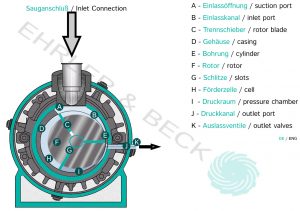ROTARY VANE VACUUM PUMPS, OIL LUBRICATED
The rotary vane technology allows a technically simple structure of vacuum pumps. A consistently high vacuum level in continuous use is guaranteed by the circulating oil lubrication, perfectly matched materials and the most modern and precise manufacturing techniques. The oil separator format guarantees clean and oil-free exhaust gases thanks to its sophisticated extraction system with integrated oil return. Compared to other technologies and device types, there is another advantage in the low start-up costs.
The advantages at a glance
- Slats with a very long service life
- High water vapor tolerance
- Optimized oil-water separation
- Low noise level
- Long downtimes
- Easy maintenance
- Diverse industrial applications
Application examples
environmental engineering
- extraction systems
- drying
Packaging
- packaging machines
- Central vacuum
food processing
- bottling plants
- cutter
timber industry
- extraction systems
- clamping devices
Industry
- extraction systems
- drying plants
- industrial furnaces
- clamping devices
Pneumatic conveying
The advantages at a glance
- Slats with a very long service life
- High water vapor tolerance
- Optimized oil-water separation
- Low noise level
- Long downtimes
- Easy maintenance
- Diverse industrial applications
Application examples
environmental engineering
- extraction systems
- drying
Packaging
- packaging machines
- Central vacuum
food processing
- bottling plants
- cutter
timber industry
- extraction systems
- clamping devices
Industry
- extraction systems
- drying plants
- industrial furnaces
- clamping devices
Pneumatic conveying
operating principle
Gas escapes via the intake port (D) a. The impeller in some pumps is mounted directly on the motor shaft for non-contact compression, resulting in increased durability. When the gas enters the side channel (A) occurs, the rotating impeller (B) spirally accelerated in direction of rotation. The effect of centrifugal force ensures that the gas in the impellers (B) is accelerated radially outwards and the pressure is increased. With each re-entry into the impeller, kinetic energy is fed back to the impeller along the side channel. The cross-section of the side channel decreases at the interrupter, the gas is scraped off by the impeller and leaves the pump through the outlet opening (C). A high degree of operational safety and a long service life, even with high differential pressures, is guaranteed by the arrangement of the bearings outside the compressor room.
*This description does not consider each manufacturer's approach to the technology, but represents a general description that attempts to cover the basic operating principle.



